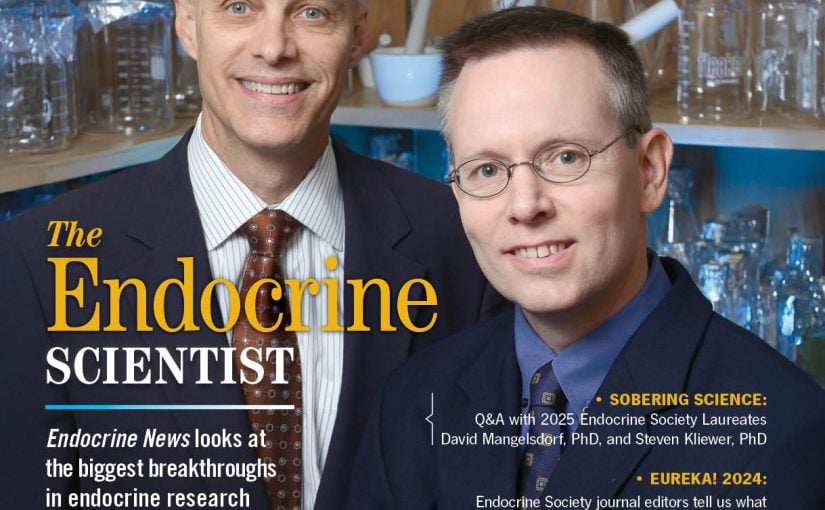Endocrine Society releases Scientific Statement on Endocrine-disrupting Chemicals
Emerging evidence ties endocrine-disrupting chemical exposure to two of the biggest public health threats facing society – diabetes and obesity, according to the executive summary of an upcoming Scientific Statement issued today by the Endocrine Society.
The statement’s release comes as Society experts are addressing a global meeting, the International Conference on Chemicals Management (ICCM4), in Geneva, Switzerland, on the importance of using scientific approaches to limit health risks of EDC exposure.
The statement builds upon the Society’s groundbreaking 2009 report, which examined the state of scientific evidence on endocrine-disrupting chemicals (EDCs) and the risks posed to human health. In the ensuing years, additional research has found that exposure is associated with increased risk of developing diabetes and obesity. Mounting evidence also indicates EDC exposure is connected to infertility, hormone-related cancers, neurological issues and other disorders.
EDCs contribute to health problems by mimicking, blocking or otherwise interfering with the body’s natural hormones. By hijacking the body’s chemical messengers, EDCs can alter the way cells develop and grow.
Known EDCs include bisphenol A (BPA) found in food can linings and cash register receipts, phthalates found in plastics and cosmetics, flame retardants and pesticides. The chemicals are so common that nearly every person on Earth has been exposed to one or more. An economic analysis published in The Journal of Clinical Endocrinology and Metabolism in March estimated that EDC exposure likely costs the European Union €157 billion ($209 billion) a year in actual health care expenses and lost earning potential.
“The evidence is more definitive than ever before – EDCs disrupt hormones in a manner that harms human health,” said Andrea C. Gore, Professor and Vacek Chair of Pharmacology at the University of Texas at Austin and chair of the task force that developed the statement. “Hundreds of studies are pointing to the same conclusion, whether they are long-term epidemiological studies in human, basic research in animals and cells, or research into groups of people with known occupational exposure to specific chemicals.”
The threat is particularly great when unborn children are exposed to EDCs. Animal studies found that exposure to even tiny amounts of EDCs during the prenatal period can trigger obesity later in life. Similarly, animal studies found that some EDCs directly target beta and alpha cells in the pancreas, fat cells, and liver cells. This can lead to insulin resistance and an overabundance of the hormone insulin in the body – risk factors for Type 2 diabetes.
Correlation between EDC Exposure and Health Threats
Epidemiological studies of EDC exposure in humans also point to an association with obesity and diabetes, although the research design did not allow scientists to determine causality. The research offers insights into factors driving the rising rates of obesity and diabetes. About 35 percent of American adults are obese, and more than 29 million Americans have diabetes, according to the Society’s Endocrine Facts and Figures report.
The Scientific Statement also examines evidence linking EDCs to reproductive health problems, hormone-related cancers such as breast and ovarian cancer, prostate conditions, thyroid disorders and neurodevelopmental issues. Although many of these conditions were linked to EDCs by earlier research, the number of corroborating studies continues to mount.
“It is clear we need to take action to minimize further exposure,” Gore said. “With more chemicals being introduced into the marketplace all the time, better safety testing is needed to identify new EDCs and ensure they are kept out of household goods.”
In the statement, the Society calls for:
• Additional research to more directly infer cause-and-effect relationships between EDC exposure and health conditions.
• Regulation to ensure that chemicals are tested for endocrine activity, including at low doses, prior to being permitted for use.
• Calling upon “green chemists” and other industrial partners to create products that test for and eliminate potential EDCs.
• Education for the public and policymakers on ways to keep EDCs out of food, water and the air, as well as ways to protect unborn children from exposure.
The statement also addresses the need to recognize EDCs as an international problem. Society members are currently meeting in Geneva for the fourth session of the International Conference on Chemicals Management (ICCM4). Attending members, including Jean-Pierre Bourguignon, MD, PhD, Professor of Pediatrics at the University of Liège in Belgium, emphasize key principles of endocrinology that are confirmed by recent research need to be taken into account when developing policies for identifying and regulating endocrine-disrupting chemicals.
“Exposure to endocrine-disrupting chemicals during early development can have long-lasting, even permanent consequences,” said Bourguignon. “The science is clear and it’s time for policymakers to take this wealth of evidence into account as they develop legislation.”
Other authors of the Scientific Statement include: Vesna Chappell and Suzanne E. Fenton of the National Institutes of Health’s National Institute of Environmental Health Sciences in Research Triangle Park, NC; Jodi A. Flaws of the University of Illinois at Urbana-Champaign in Urbana, IL; Angel Nadal of the Institute of Bioengineering and CIBERDEM at Miguel Hernandez University of Elche in Elche, Alicante, Spain; Gail S. Prins of the University of Illinois at Chicago in Chicago, IL; Jorma Toppari of the University of Turku and Turku University Hospital in Turku, Finland; and R. Thomas Zoeller of the University of Massachusetts in Amherst, MA.
“Executive Summary to EDC-2: The Endocrine Society’s Second Scientific Statement on Endocrine-disrupting Chemicals,” was published online in Endocrine Reviews.
The Society will hold a Twitter chat on EDC exposure and associated health effects on Thursday, October 1 at 1 p.m. Eastern. Gore will serve as the expert and share information on the Scientific Statement. To follow the discussion moderated by @TheEndoSociety, use the hashtag #EndoChat.

